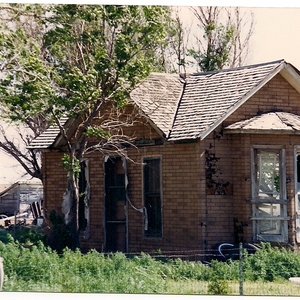I remodeled a rental unit and as required by code used an arc fault breaker for the bedroom outlets. the inspecter said the lighting in the bedroom must be flouresent, or motion detector or dimmer and must be arc fault protected and also the smoke detector. the smoke detector is on the bedroom circuit and trips the arc fault. the dimmer trips the lighting circuit. anyone know whats up. i havn’t heard of the arc fault requirement for smoke detectors and lights. any help greatly appreciated. teraf sacramento,ca
Discussion Forum
Discussion Forum
Up Next
Video Shorts
Featured Story

Few people understand it. Nobody agrees what it is, how to learn about it, or who's responsible for it. It has never been more important
Featured Video
How to Install Cable Rail Around Wood-Post CornersHighlights
"I have learned so much thanks to the searchable articles on the FHB website. I can confidently say that I expect to be a life-long subscriber." - M.K.

















Replies
The current NEC rquires that all 120v OUTLETS in bedrooms be AFCI protected.
An OUTLET in codish is anyplace that electricity is used. But it includs lights and smokes and others.
Part of the AFCI is a circuit that detects ground faults, but the spec if different and it can not be used for personal safety protecttion (but the is at least one does both).
For the smokes I would check make sure that the neutral is not connected to another neutral or the ground at anyplace.
And for the dimmer does it trip if you reset it with the dimmer full on or full off when reset? Or only when the dimmer is changed?
Also verify that the neutral is not grounded or connected to another neutral.
Are these all on one AFCI? How have you isolated the problems to that part of the wiring?
.
.
A-holes. Hey every group has to have one. And I have been elected to be the one. I should make that my tagline.
Edited 4/21/2007 9:39 pm by BillHartmann
That's an interesting point on the smoke detectors. If they have a common alarm wire running between them they all need to be on the same circuit. Even without AFCI/GFCIs they would need to be on the same leg of the 240 line, but with an AFC/GFCI they'll likely cause a (not quite so) "false trip" if not all on the same device.
So convenient a thing it is to be a reasonable Creature, since it enables one to find or make a Reason for everything one has a mind to do. --Benjamin Franklin
thanks bill. the smoke alarms 2, are on my bedroom circuit. i was unaware of the code requiring arc faults for the bedroom light. I have one lighting circuit for the 500 sq. ft. apt. with dimmers in living, dining and bedroom. closet bath and kitchen completes the circuit. 15amp. these units are two cottages and all electrical is new. I put a 15a arc fault on each wiring circuit and the they both trip. I will try taking the 3 way dimmer in the living room and dimmer in dining room and replace with standard switch and see if that helps. teraf
will try taking the 3 way dimmer in the living room and dimmer in dining room and replace with standard switch and see if that helps
Probably will help, commercial AFCI are not 'smart' enough to distinguish an SCR turn on vs arc.
Most likely the problem is not with the dimmers, but as I said a ground/neutral connection someplace.And it can be an over driven staple or where the wire enters a box if you have many metal secrew down clamps.I would not "replace" anything before doing some more testing. Just disconnect the dimmers to see if they have any affect.About 1/2 way through the circuit disconnect the remaining. If you still have the problme the it is in the 1st half. Otherwise it is in the 2nd half..
.
A-holes. Hey every group has to have one. And I have been elected to be the one. I should make that my tagline.
Simple test is to temporarily replace the AFCI with a GFCI.
So convenient a thing it is to be a reasonable Creature, since it enables one to find or make a Reason for everything one has a mind to do. --Benjamin Franklin
bill the problem was with the neutral as you suggest. how about 8 neutral?s. in my rush to get the breaker in for the inspection i neglected to take the circuit neutral off and connect it to the arc fault breaker. embarrased, teraf, thanks again Bill
I was going to suggest that, but I though that most of them worked and it was only two that you where having problems with.Glad that you found it..
.
A-holes. Hey every group has to have one. And I have been elected to be the one. I should make that my tagline.
You are living in the capital of the nanny state. The only law they haven't heard of is the law of unintended consequences.
What you do is buy the arc fault breaker from Home Depot and KEEP THE RECEIPT. After the installation passes, take the arc fault back to HD and get a regular breaker. If you want the protection, get a GFCI breaker since the active ingredient of an AFCI seems to be the ground fault mechanism. [Refer to Mike Holt's newsletter of Monday, Dec 9, 2002.]
We professional electricians in the field seem to be quite dubious about the effectiveness and supposed mechanism of the AFCI. Ground faults we can understand but arc faults are supposed to have a signiture of a high spike at the peak of the sine wave. Do the AFCIs have a little occiloscope in them?
If your wiring is in good shape and the connections are tight [$150 torque screwdriver anyone?], you shouldn't have any arc fault problem. If your wiring is old knob and tube, then it is grandfathered in.
Where are the statistics showing any decreased incidence of electrical fires due to the use of these devices.
The best marketing ploy ever is to get the government to pass a law requiring everyone to buy your product.
~Peter
well said
thanks, your info is greatly appreciated
You can't return a breaker.Rebuilding my home in Cypress, CA
Also a CRX fanatic!
>You can't return a breaker.
Didn't you see the key words "Home Depot"
Every one I've been to has a nifty little sign in electrical that says "Be sure to check your purchase, because breakers cannot be returned". It seems to be the one thing Big Orange doesn't take back.Rebuilding my home in Cypress, CA
Also a CRX fanatic!
I returned two breakers to HD, no problem
I find it hard to believe that you are a 'professional electrician' and then counsel someone to break safety regulations and code rules! As an Electrical Safety Officer you would be charged and fined and posiibly loose your licence if it was found that someone removed the required AFCI breaker after an inspection was performed. How can we find out after the fact? Try selling the building and getting a sucsessful inspection, or wait for me to show up after a fire and perform an inspection! (and God help you if someone was hurt or killed.) If you have an AFCI breaker protecting that circuit and the breaker keeps tripping, there is something wrong with the wiring... or a device connected to it (eg: an older style clock radio with a mechanical relay for alarm activation will trip it) These breakers are built with a small (but powerfull) micro-processor built into them with the waveform signatures of approx 500 types of arcing faults. An arcing fault is a high impedance (resistance) type of fault that will allow enough current to flow to cause a fire but a regular (or GFCI) type breaker will only see that current flow as acceptable. The GFCI will trip once the fire gets going enough to cause a fault to ground through the carbonization of the wiring insulation within that area of origin. An additional piece of information, within our jurisdiction, a smoke or CO alarm is NOT permiited on a circuit that has a AFCI or GFCI breaker protecting it.The secret to life is honesty and fair dealings...
If you can fake that, you've got it made!!!
"safety regulations and code rules!"First of all the only code is what is adopted locally. And, just because of these kind of issues with AFCI's they have adopted amendments to not require AFCI's."As an Electrical Safety Officer you would be charged and fined and posiibly loose your licence if it was found that someone removed the required AFCI breaker after an inspection was performed."Once he leaves the building he has not authority or responsibility on what the HO might do later."Try selling the building and getting a sucsessful inspection,"What kind of INSPECTION? There are few code inspections on sales and even when they do have them they are using more insterested in checking for smokes."or wait for me to show up after a fire and perform an inspection!"And then what?How do you know that who removed them?"An arcing fault is a high impedance (resistance) type of fault that will allow enough current to flow to cause a fire but a regular (or GFCI) type breaker will only see that current flow as acceptable."Not exactly the current AFCI's only detect low resitance parallel arcs."The GFCI will trip once the fire gets going enough to cause a fault to ground through the carbonization of the wiring insulation within that area of origin.'And with series arcs, with I think are most common, that is exactly what happens the connection gets hot and melts the insulation, sometimes with a flame. And that inturn causes the 30 ma ground fault circuit in the AFCI to trip. AFTER THE FIRE STARTS.Check past discussions on this issue. They have links to manfuactures websites that indicatate that."An additional piece of information, within our jurisdiction, a smoke or CO alarm is NOT permiited on a circuit that has a AFCI or GFCI breaker protecting it."Unfortuanely areas that have adopted the 2002 or later NEC, without amending that seciton, don't have that options..
.
A-holes. Hey every group has to have one. And I have been elected to be the one. I should make that my tagline.
Bill,
I just want to thank you for your excellent defense of my points.
A further point is the cost effectiveness of the AFCIs. That is, if they cost ~$30 each vs. ~$8 for a standard breaker, then a 30 space panel would cost an additional $660 per house. Wouldn't this money be better spent on other aspects of electrical safety such as adding additional outlets and using a better grade of receptacles rather than the 39c stab-in-the-back ones?
This being "charged and fined" business is just scare tactics. As a free citizen, I am just expressing my opinion on this bogus junk which is about to be foisted on us. It is interesting to learn that they have identified 500 unique signitures of different types of arc faults. The obvious question is: did they leave anything out?
~Peter
I never heard that 500 signatures before this thread.And next year the are requiring combination (detect both series and parallel arcs) AFCI's and they aren't even commonly available yet. This is in the 2005 NEC.Those will be much more subject to false tripping from things like vacuum cleaners.And the 2008 NEC proposal was to require all circuits in a home to be AFCI protected. .
.
A-holes. Hey every group has to have one. And I have been elected to be the one. I should make that my tagline.
500 signatures
Wondered where that came from also, in advertisments mostly ??...... 500 is a very low number, have not seen that number in any technical papers.
Some of the first arc fault signatures were gathered on DuMont scopes in the late 30's. There are well over 500 papers in the literature since then.
A $30 breaker cannot even start to detect an arc while at the same time discriminating from brush arcs on a vacuum cleaner, etc, but it can be done.
The 'protect us all' spec folks would probably like to have each room of the house with a 1 meter complementary log spiral antenna hooked to a 5 GHz scope and current xfmrs on every line, all fed to a 3 GHz Pentium processor -- that is what it takes to do real 'fault' discrimination from nuisance sources.
Pix is of the partial discharge (glow, incomplete arc) signature of a 1 HP 600 V motor drive at 40,00 ft altitude and is an arc as discriminated from motor drive IGBT switching and diode reverse recovery. Top is radiated signature with 20 MHz filter, bottom is the line current. Processing this type data in a $30 breaker is not within technology of today. Houses with 240 V variable speed motor in the furnace or AC would likely set of an AFCI also.
Like PM22 says, conspiracy to seperate us from $$ thru fear via the uneducated.
after looking at that display , I'm wondering if the arc from a failing incandescent lamp would trip those stupid things.
.
.
., wer ist jetzt der Idiot ?
In theory it should.
So convenient a thing it is to be a reasonable Creature, since it enables one to find or make a Reason for everything one has a mind to do. --Benjamin Franklin
these devices are going to be like the "service engine light on the dashboard
.....4758 things could be wrong with the wiring.
also since these breakers use power they will help to run up the electric bill too. not very green
. either
.
.
., wer ist jetzt der Idiot ?
Edited 4/22/2007 9:56 pm by maddog3
Edited 4/22/2007 9:57 pm by maddog3
I don't see the point of becoming too doctrinaire about AFCI's and code rules. This is probably the most contentious part of the NEC these days, and evidence is mounting as to their problems. For this reason, AFCI requirements have not been adopted in many places. As for professional responsibility... if something IS mandated by law, and you advise that the law be violated, you have at the minimum given bad advice, and at worse become part of the crime. Sure, proving the case may not be easy ... but that does not eliminate the crime. A robbed bank is still a robbed bank, whether or not the thief is caught. The best advice here is to a) hire a responsible pro (and not some jive=talking self-appointed 'street lawyer), and 2) make sure you know what the law really says. You do have a professional on your payroll, to answer such questions. He's called your local inspector. Talk to him first.
Service engine light isn't so bad, since you can hook up a reader and find out what's wrong.
So convenient a thing it is to be a reasonable Creature, since it enables one to find or make a Reason for everything one has a mind to do. --Benjamin Franklin
right, maybe that was a poor analogy, but this hocus-pocus has got to keep an eye on so many different things and figure out which one is the correct fault to trip on, and there ain't no way a receptacle is that damn smart unless of course everything for roughing - in gets redesigned too accomodate all the stuff junkhound listed earlier.
.
.
., wer ist jetzt der Idiot ?
The spec on the current AFCI's is for PARALLEL arc of 70 amps. But the RMS value is low enough that a 15/20 amp breaker won't trip.In most cases I would not think that would be too difficult to have an algorithm to detect that without false trip problems.I am guess that the UL standard on the AFCI's have one or more test signatures that used to test them.But the new ones are also suppose to detect 5 and 10 series arc.How much different that the arcing of a vacuum cleaner motor.That is the interesting one..
.
A-holes. Hey every group has to have one. And I have been elected to be the one. I should make that my tagline.
As an Electrical Safety Officer you would be charged and fined and posiibly loose your licence if it was found that someone removed the required AFCI breaker after an inspection was performed."
Once he leaves the building he has not authority or responsibility on what the HO might do later.
Yes and no. The contractor retains responsibility for the workmanship and installation essentially forever. If he can PROVE the HO changed the breaker, he's off the hook, but that would be really hard to prove. When the house burns because of an arc fault, you can bet the HO is not going to admit to it, even if he did, so the contractor will be the one held responsible. The insurance company has lots of high priced attorneys to make sure that happens.
If you have an AFCI breaker protecting that circuit and the breaker keeps tripping, there is something wrong with the wiring
Nah, there is something wrong with the design of the AFCI!!!!!!!!!
Note: grammer followin' is zo the poster cin understained....
Holie crap!. 2nd post and you says you an 'eginear' and 51 YO and spout BS about how great commercial AFCI is! You cots a lot to learn boy about poor engineering of some commercial devices, yu must be part uv the mfg team of the crap AFCI's bein' foisted commercial like.....
Agree with previous posts that commercial AFCI are primarily for enrichment of mfg.
BTW, IDKWITA: me was part of design team in '93 that did GFCI and AFCI for the space station, there were a few of your type that got lottsa crap added to the circuitry by way of litigation type fear mongering to management and nasa ......... that most has now been disconnected 'cause nothing would work with all the "protection". Some good friends in Huntsville have AFCI patents, but commercial breakers would need at lesat a 286 chip to handle the processing - nice to force that on the public for 120 V systems for no real benefit. Great benefit for fighter aircraft at 270 VDC and at over 80,000 ft. altitude however!.
Great! Now not only do I have to buy a $35 breaker, but I have to replace my antique clock radio! How about the mechanical clock/relay powering my fan?This is progress? Why not include the waveform signatures of all appliances as OK?Sounds like the same people that are forcing HDTV upon us and have us scrap all the non-HDTV sets. What a waste of money and landfill space.Frank DuVal
The waste re HDTV is not having the $50 converters that were promised ten years ago. They could make them, but they'd rather force everyone to buy new TV sets.
So convenient a thing it is to be a reasonable Creature, since it enables one to find or make a Reason for everything one has a mind to do. --Benjamin Franklin
I'd take a close look at your connections of your wires to your boxes. I've had tripping AFI breakers, and it always ended up that I had mashed the romex too much on the wire clamp into the metal box. It didn't trip a regular breaker, but it did an AFI.
BTW, if that rental unit burns down next year, do you want the papers to read that you had removed vital fire safety equipment from the electrical system?
Rebuilding my home in Cypress, CA
Also a CRX fanatic!
Maybe it should be "MFCI".
Yes, thanks.
I corrected it.
.
A-holes. Hey every group has to have one. And I have been elected to be the one. I should make that my tagline.